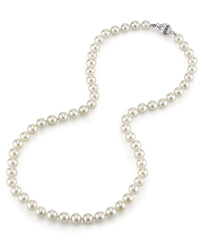
Japanese Akoya White Pearl Necklace, 6.5-7.0mm - AAA Quality
$1,540.00 Sale: $1,232.00

The jewelry world is defined by certain enduring word associations. Diamonds and their brilliance, gold and its shine but most specially, pearls and their luster. Wherever there is talk of pearls, luster quickly becomes the focal point of the discussion.
There are different ways to describe a pearl’s luster – mirror-like, glassy, sharp, metallic, silky, satiny, waxy and the much dreaded, dull. Even within pearls, as a gem category, different types of pearls exhibit their own distinctive luster. The luster of a gem-quality freshwater pearl is softer and silkier when compared to the very shiny luster of a gem-quality Akoya pearl. In fact, the Hanadama Akoya pearls have such exceptionally strong, very high-wattage luster that no other cultured pearl comes close to it. Tahitian pearls have great luster too, but it has a satiny, luxurious rather than a metallic quality to it. South Sea pearls, by comparison, both white and golden, have a deep lustrous glow, such that it seems as if these pearls are lit from within.

Akoya Pearl Necklace, 7.0-7.5 mm, AAA Quality, Pearls of Joy
According to the GIA (Gemological Institute of America), luster might be the most important of the seven factors that are used to determine the value of a pearl. For instance, a strand of pearls with some blemishes but with sharp, attractive luster will be more valuable as compared to a clean strand with low luster, if all other things are equal. This is because luster can easily be seen and assessed by the naked eye, without requiring any special tools. And it is one of the first things that a person, consciously or subconsciously, notices about pearls.
Very simply, luster is the quality and quantity of light that is reflected off, and from just under, the surface of a pearl. An easy way to assess the luster of a pearl is by looking at the image reflected on its surface. GIA has established the following continuum to explain why some pearls are graded as high luster and others as dull:
• Excellent luster means that the image reflections on the surface of the pearl are bright, crisp and very sharp
• For pearls with very good luster, while the image reflections remain bright, they may be just shy of being very sharp
• Good luster means that the image reflections may be bright but they are not sharp; in fact, the edges may be blurred
• For pearls with fair luster, the image reflections are weak and blurred and the pearl itself may not appear very bright
• Finally, poor luster is seen when the image reflections are dim, diffused and very blurred

White Freshwater Pearl Bracelet, White Freshwater Pearl Ear Studs, Pearls of Joy
The luster of a pearl is intimately related to the way light interacts with a pearl. In this regard, the thickness and quality of a pearl’s nacre becomes especially important. When we describe luster as the shine or glow of a pearl, what we are talking about is refraction or how well the light beams break up when going through the concentric inner layers of nacre and then get directed back to the viewer. The round shape of a pearl acts as a convex mirror, reflecting light so that it seems as if the light is coming from within the pearl.
This process of refraction also gives pearls their unique iridescence or orient. Layers of nacre act like microscopic prisms, breaking light as it is reflected back, and in the process creating colorful, secondary colors that appear to skim on the surface of the pearls. Pearls with thin nacre appear chalky and lifeless, while those with thick nacre have a rich glow and many will also have secondary “overtone” colors, shimmering on their surface. The thickness of nacre depends on the type of pearl (many freshwater pearls are all nacre as compared to saltwater pearls which are bead-nucleated) and on how long the oyster stays in water (with longer durations yielding thicker nacre).
Luster is also affected by the surface condition of a pearl. Pitted or blemished pearls will have lower luster as compared to pearls with smooth, unbroken surfaces. This is because the interaction of light with the layers of nacre is disrupted by the pits and cracks on the surface of the pearl.

White South Sea Pearl 'Ryler' Earrings, Pearls of Joy
Luster, in pearls, has a special pull. It attracts and captivates and makes us want to reach out and touch these iridescent gems. But why is it that jewelry aficionados are drawn to luster, that bright, highly lustrous pearls are always preferred over those that are dull and dim? The answer, to some extent, can be found in evolutionary science and psychology. Humans have always been attracted to shiny, glossy things. This preference is a natural, survival instinct connected to our innate need for water, shiny and life-giving. Hence, the one thing, that sets high quality pearls apart is their luster. The more lustrous a pearl, the more attractive it is, not just because of its perceived value but even at a deeper, psychological level.
Pearls with high luster have a glossy sheen which reflects images sharply and brightly. In addition, these pearls seem to glow from within and exhibit a myriad of different secondary colors or overtones on their surface. These qualities add to the value of the pearls, at an economic and psychological level. Conversely, pearls with poor luster appear lifeless and dull. Whether you are buying pearls for yourself or as a piece of jewelry you would like to pass on to your children, you can never go wrong by going for high, excellent luster.
Featured Image: Multicolor Tahitian Pearl Necklace and Tahitian Pearl 'Ayla' Ring, Pearls of Joy
Reema Farooqui is a content writer who loves pearls and pearl jewellery. You can find her on her website The Culture of Pearls or on Instagram at @thecultureofpearls